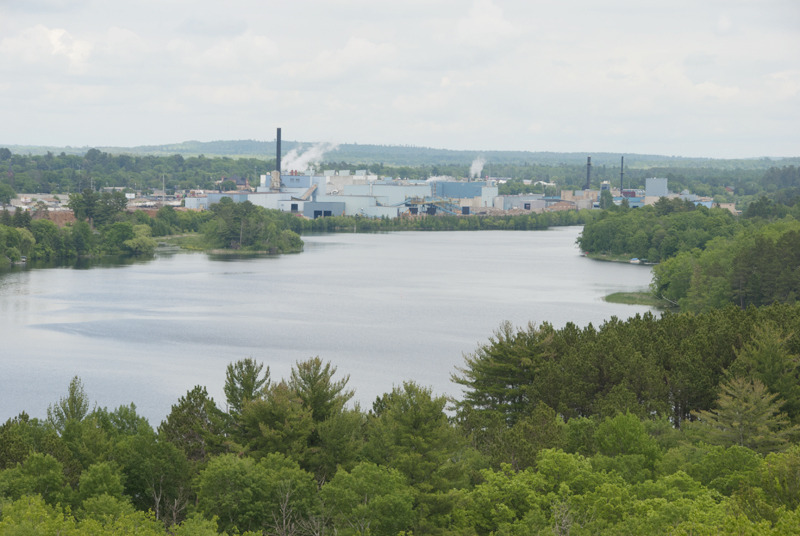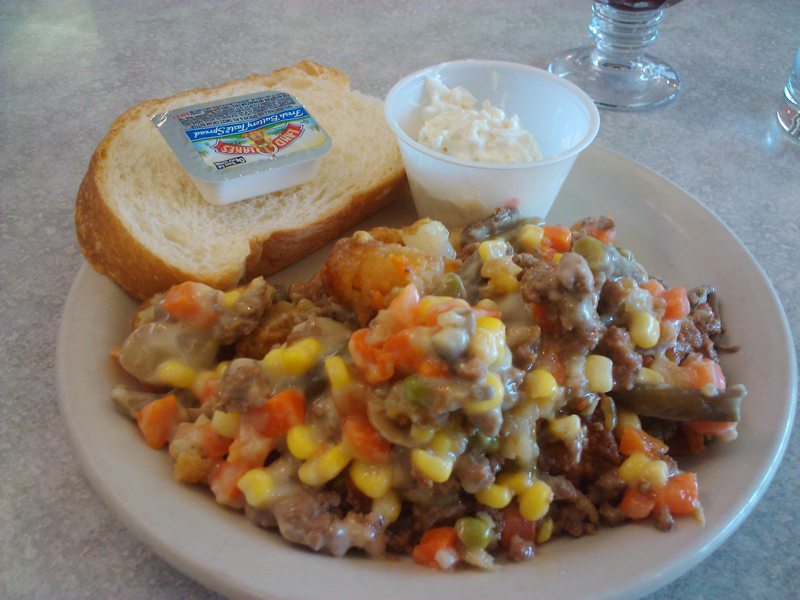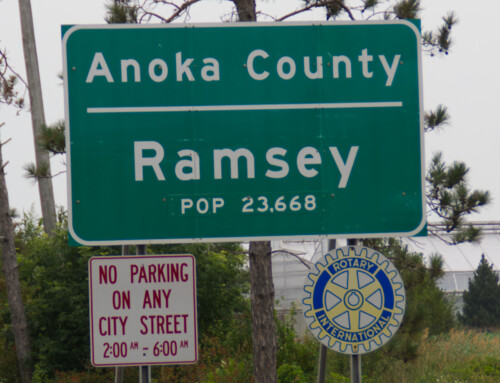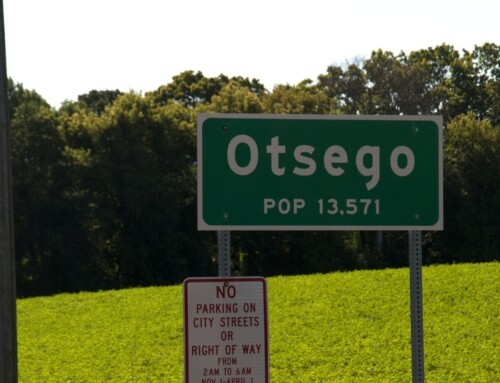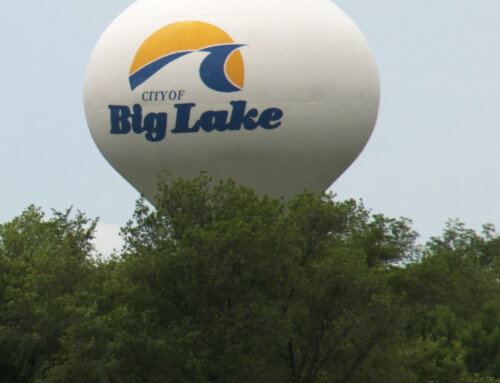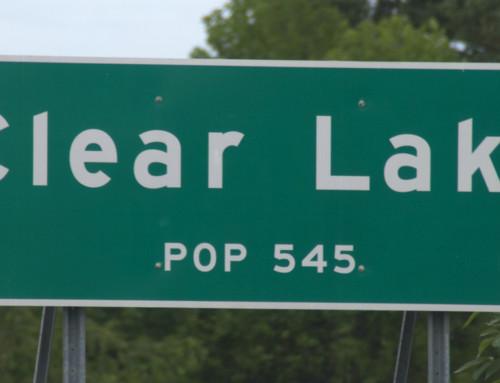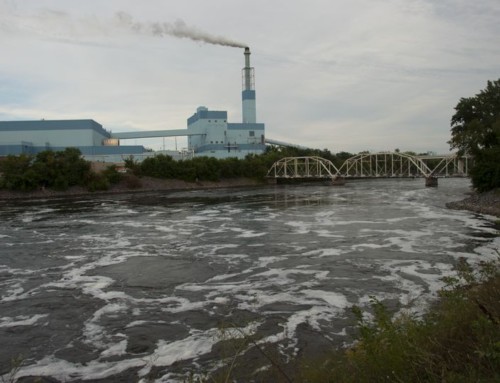Introduction
Grand Rapids is at the hub of a fascinating area: on the southwestern edge of the Mesabi Iron Range, in the middle of the pine forests and the northern Minnesota resort scene, and along the Mississippi River where it finally begins to turn south. Grand Rapids is also the government center for Itasca County, which, at 2,844 square miles, is bigger than two US states.
Visitor Information
Visitors can load up on brochures and information at Visit Grand Rapids (10 NW 5th St.; 218.326.9607), which is located on the second floor of the historic old schoolhouse.
History
The city of Grand Rapids was founded at the foot of 3½ miles of rapids and grew into the main supply point for logging camps within a hundred mile radius. When W.W. Winthrop passed the rapids in 1857, he named them Pokegama and wrote the following description:
“Pokegama is the most interesting and romantic point on the Mississippi above St. Anthony. The river rushes through a narrow pass, with a bold, rocky bank on the northern side, and over a rocky bed, and with a roar audible at a considerable distance. There is no distinct fall, but continuous rapids for about a quarter of a mile capable of furnishing very great water power for future mills.”
In 1858, the year Minnesota was admitted to the Union, the North Star (later rechristened the Anson Northup) became the first steamboat to navigate to the rapids, carrying sightseers on an excursion from Fort Ripley. While it was impractical for steamboats to travel the entire route from the Twin Cities to Grand Rapids, the stretch from Aitkin to Grand Rapids had regular service for several decades.
Logging began in the late 1860s; the first batch of cut timber rolled down the rapids in 1868. When Warren Potter built his store at the rapids around 1872, there were 17 logging camps close to Pokegama Falls. Saloons were at the center of the social economic life in the early years. Many served food and offered overnight accommodations, and liquor licenses were among the few sources of revenue for the young village.
Grand Rapids won the county seat in 1892 but not without some of the usual hijinx. Rivals at the village of La Prairie looked to have the upper hand, helped by a newspaper that acted as a strong voice for the community. Advocates for Grand Rapids, though, managed to convince the owner to move the paper to their town and switch sides. The La Prairie Magnet became the Grand Rapids Magnet and pushed for the county seat in its new home. When it came time to vote on the county seat, some outlying areas reported more votes than residents. A clerk in one remote precinct, when asked who voted in his area, replied “Everything with hair on it.” Oxen apparently wanted their voices heard in the election, too. On a ballot, the name of an ox often appeared next to its owner’s surname. Then again, maybe it was just hard to tell the men from the oxen in winter.
You probably won’t be surprised to learn that the area attracted a lot of immigrants from northern Europe. In the 1905 census, about a quarter of Itasca County residents were born in Sweden, Norway, or Finland; another 10% were from Canada.
The Itasca Paper Mill opened in 1901, producing 30-40 tons of paper a day right out of the gate. In 1916, C.K. Blandin, the owner of St. Paul Dispatch and St. Paul Pioneer Press, purchased the plant to ensure a reliable supply of paper for his business. Blandin sold the newspapers in 1929 to focus exclusively on the paper mill. The plant is still operating, though it is now owned by the Finish company UPM.
Iron ore was discovered in the Mesabi Range in 1890 and the first trainload was shipped out two years later. By 1960, over two billion tons of ore had been mined at locations as close as two miles from Grand Rapids. The mines are still active today, but production has dropped well below peak levels.
Grand Rapids today relies on tourism, logging, health care, light manufacturing, and education; Itasca Community College is consistently rated as one of the best in the country.
Exploring the Area
Don’t miss the Forest History Center (2609 County Road 76; 218.327.4482), where you can experience a taste of life in the logging camps with the help of living history actors; let a naturalist teach you how to identify which critters are sharing the woods with you by identifying their tracks and scat; and climb a 100-foot tall fire tower for a wide panorama of the area.
The MacRostie Art Center (405 NW 1st Ave.; 218.326.2697) features the work of local and regional artists with rotating exhibits.
When Paul Bunyan passes through town, he can kick back for a rest in the oversized Adirondack chair built by artist Doug Heiken (southeast corner of 4th St. NE/US Highway 2 and Pokegama Ave./US Highway 169).
The Itasca County Historical Society (201 N. Pokegama Ave.; 218.326.6431) has exhibits on native daughter Judy Garland , as well as the woolly mammoth and the area’s fur trading, mining, and logging history.
And speaking of that native daughter, the Judy Garland Museum (2727 Pokegama Ave. S; 218.327.9276) is working to keep her legacy alive. Born Frances Ethel Gumm on June 10, 1922 in Grand Rapids, Judy was two when the family moved to California. The museum is the only one in the US focused on Judy Garland and is a fun place to visit. You will find a thorough overview of her movie career; a nicely restored period house, and the Children’s Discovery Museum.
The Grand Rapids State Bank (523 NW 1st Ave.; 218.326.9414) has an impressive collection of taxidermy, thanks to the Wilcox family who are avid hunters. Some of the animals in the bank include jackal, cape buffalo, wart hog, and kafue lechwe.
The Chippewa National Forest has a number of trails and attractions within a short drive from Grand Rapids. One of the best is the Joyce Estate on Trout Lake. Built by industrialist David Joyce, whose family made part of its fortune from logging in northern Minnesota, the 4,500-acre escape was the family retreat from the city for over 50 years. At its peak, the estate had 40 buildings, a golf course, and a hangar for a seaplane. It will take about 25 minutes to drive to the trailhead from Grand Rapids, then it is a fairly easy three-mile hike (one-way) through a second-growth forest to reach the estate.
The Edge of the Wilderness National Scenic Byway is a scenic 47-mile drive from Grand Rapids to Effie along Minnesota Highway 38. Most of the drive takes you through the Chippewa National Forest. Along the way, you’ll cross the Laurentian Divide. Water on one side of the divide goes to the Mississippi River and down to the Gulf of Mexico, while water on the other side flows into one of the streams that feed Hudson Bay.
Itasca Community College (1851 US Highway169; 218.322.2300) maintains several hiking and cross country skiing trails behind the campus. The bog trail might be the most interesting walk; if your timing is good, you can see blooming orchids, pitcher plants, and Labrador tea, among other plants, many helpfully identified with signs, plus a few old growth red and white pines. To get there, follow US 169 to the northeast end of town; take the first left onto campus; circle the roundabout to the main ICC/USFS entrance, then follow that road as it becomes a gravel road and passes through a pasture (if you encounter a closed gate, it is OK to open it and drive through; just close the gate behind you). At the point where the road turns left and the road going forward looks more like a groomed trail than a road (the 3rd left after the road turns to gravel), turn left and find a place to park. You will find the trailhead just past a narrow service road. As you double back to leave, take a quick detour to the first road on your right to check out stands of red and white pine that were planted in 1900.
There are a few city parks next to the Mississippi River:
- Veterans Memorial Park (10 NE 8th Ave.) is a pleasant place to picnic or hang out next to the Mississippi River; there are also a couple of miles of hiking trails through the woods.
- Riverfront Trail Park (140 NE 2nd St.) is a quiet place to sit or stroll along the river below the dam and behind the library.
- Skogebo Park (805 SW 1st St.) is just above the dam.
- Sylvan Point (1225 SW 1st St.) has a fishing pier and picnic tables.
The Mesabi Trail is a paved path through the Iron Range that will someday connect Grand Rapids with Ely; about 120 miles are open right now, with more sections to be completed soon. The trail is open to non-motorized use throughout the year (e.g., biking and hiking in summer; cross-country skiing and snowshoeing in winter). You must purchase a pass to use the trail.
There are nearly 150 miles of groomed cross-country ski trails near Grand Rapids and even more miles of snowmobile trails.
The Itasca Curling Club (934 Hale Lake Pointe; 218.999.5875) sponsors leagues that compete most weeknights; drop in to watch a match and to learn about the sport.
Getting on the River
Paddlehoppers (17 County Road 63; 218.326.5853) can set you up with a canoe, kayak, or stand-up paddleboard for an hour or several days, depending upon your ambition; they can also provide shuttle service.
Tours
The UPM/Blandin Paper Mill (NW 2nd Ave. at NW 3rd St.; 218.327.6682) offers 45-minute factory tours in summer. There are no set tour times; just show up on tour days (W-F 10-4 from June-Aug.; free; no one under 12 years old; no cameras; closed-toe shoes only). NOTE: Call ahead to make sure that tours are running on the day you want to visit.
Entertainment and Events
If you want to see a musical, play, dance performance, concert, or similar show while in town, check the schedule for the Myles Reif Performing Arts Center (720 NW Conifer Dr.; 218.327.5780). The center also has an art gallery.
The First Friday Art Walk showcases the arts in several places downtown that are within walking distance of each other. It’s a great way to hang out with people from the area, and most events are free.
Farmers Market
The local farmers market (701 NW 4th St.) operates on Wednesdays and Saturdays from May through October.
Festivals
In June, the Judy Garland Museum hosts a Judy Garland Festival.
One of the most popular events is the Northern Cruisers Weekend of Wheels Car Show, which draws thousands of visitors in late July. You’ll have a hard time finding a place to stay unless you book a room in advance.
Tall Timber Days is another popular event, as the city celebrates its history with food, music, and a grand parade; it is usually the first weekend in August.
The Itasca County Fair (mid-August; 1336 Fairgrounds Rd.; 218.326.6470) offers the usual county fair fun, like old-school amusement park rides, farm animal beauty pageants, food booths, and entertainment at the grandstand.
**Grand Rapids is covered in Road Tripping Along the Great River Road, Vol. 1. Click the link above for more. Disclosure: This website may be compensated for linking to other sites or for sales of products we link to.
Where to Eat and Drink
Klockow Brewing Company (36 SE 10th St.; 218.999.7229) produces am impressive range of tasty beer which you can enjoy in a spacious setting. On Saturday evenings, they host live music.
Rapids Brewing Company (214 N. Pokegama Ave.; 218.999.9712) is another good choice for local craft beer. New beers roll out regularly and you can enjoy them with a meal (pizza, sandwiches, salads, soups) in a converted theater.
Brewed Awakenings (24 NE 4th St.; 218.327.1088) is the spot for good coffee and fresh food with organic ingredients.
Zorbaz is a northern Minnesota chain that serves up good pizza and good drinks at reasonable prices. The Grand Rapids restaurant is south of town on Pokegama Lake (32946 Crystal Springs Rd.; 218.326.1006); they can get very busy on weekends.
The name says it all for Dottie’s Hometown Café (324 4th St. NE; 218.326.8858), as this place feels like the kind of small town diner that gave such diners a good name. Breakfast might be the best time to eat here, with a wide range of affordable choices that includes corn beef hash and three-egg omelets.
For a taste of a local tradition, stop at Pasties Plus (1405 NW 4th St.; 218.326.2234) , where you can eat like a miner. Pasties (pronounce it with a short “a” to get the food treat or a long “a” to get the clothing accessory worn by exotic dancers) are Cornish in origin but became popular with many mine workers because they are portable and easy to eat. It is essentially a piece of pastry dough stuffed with meat and vegetables and folded over in the shape of a big dumpling. You can eat one at the store or buy some to take with you.
Forest Lake Restaurant (1201 NW 4th St.; 218.326.3423) is another popular choice for a steak or seafood dinner in a casual setting.
Where to Sleep
Camping
Eight miles southeast of Grand Rapids on the Great River Road, Golden Anniversary State Forest permits primitive camping at dispersed sites.
There is also a campground at the Itasca County Fairgrounds ((1336 Fairgrounds Rd.; 218.326.6470; open May-Sept.). The sites are a little bigger than average but most are in a big field without much separation; the back half of the campground feels more woodsy.
Prairie Lake Campground & RV Park (30730 Wabana Rd.; 218.326.8486) has a scenic lakeside setting with lots of tall trees for shade, a swimming beach, and canoes at your disposal.
Bed and Breakfast
For a relaxing getaway, stay in one of the two rooms at the Green Heron Bed and Breakfast (2810 Meyers Bay Rd.; 218.999.5795). Less than ten minutes from central Grand Rapids, the B&B offers a sandy beach on Lake Pokegama, use of kayaks or a canoe, a private modern room with en suite bathroom, and a full breakfast.
Resorts near town
Southwood Resort (32460 Southwood Rd.; 218.259.8886) is the prototypical mom-and-pop resort. They rent four cabins and a 24’ camper; units are updated, in great shape, and decorated with knotty pine paneling; located on Pokegama Lake.
Budget lodging
The Forest Lake Motel (1215 4th St. NW; 218.326.6609) has spacious and well-kept rooms that are all equipped with coffee, microwave, and a small fridge.
Rooms at the Itascan Motel (610 Pokegama Ave. S; 218.326.3489) are in good shape and evoke a vintage 1960s feel; all are equipped with coffee, a microwave, and a small fridge; the motel also has a number of kitchenettes.
Moderate and up
Timberlake Lodge Hotel (144 SE 17th St.; 218.326.2600) is a Northwoods-themed hotel with beautiful rooms in an uninspiring part of town. All rooms are equipped with a coffee maker, a microwave, and a small fridge.
Getting There
Jefferson Lines offers long-distance bus service; they stop in Grand Rapids at the Super 8 Motel (1702 S. Pokegama). Your best bet is to purchase tickets online (they are not refundable); you’ll need to print a boarding pass and be prepared to show an ID when you board. You can also buy a ticket on the phone (800.451.5333). If all else fails, you can show up without a ticket, and the driver may let you ride to the next station that sells tickets where you can buy one.
Where to Go Next
Heading upriver? Check out Cohasset.
Heading downriver? Check out the Mesabi Iron Range.
Community-supported writing
If you like the content at the Mississippi Valley Traveler, please consider showing your support by making a one-time contribution or by subscribing through Patreon. Book sales don’t fully cover my costs, and I don’t have deep corporate pockets bankrolling my work. I’m a freelance writer bringing you stories about life along the Mississippi River. I need your help to keep this going. Every dollar you contribute makes it possible for me to continue sharing stories about America’s Greatest River!
Grand Rapids Photographs
©Dean Klinkenberg, 2012

